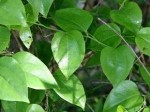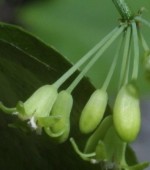 Hikers abhor this prickly perennial vine found in woodlands of the East Coast south to Florida and west to Michigan and Texas as it blocks their way and inflicts considerable pain if they try to fight it. A native of eastern United States, it winds its way through shade-loving shrubs or forms thickets that block animals and humans from penetrating the areas they guard. They can cause considerable concern when they invade. On the other hand, greenbriers provide shelter, nesting sites and berries for many animals.
Hikers abhor this prickly perennial vine found in woodlands of the East Coast south to Florida and west to Michigan and Texas as it blocks their way and inflicts considerable pain if they try to fight it. A native of eastern United States, it winds its way through shade-loving shrubs or forms thickets that block animals and humans from penetrating the areas they guard. They can cause considerable concern when they invade. On the other hand, greenbriers provide shelter, nesting sites and berries for many animals.

 Description: Greenbriar is a diceduous vine that grows up to 20 feet and is armed with sharp thorns up to ¼ inch long. The green stems are angled and bear two 2 inch long tendrils at the base of the leaf petioles. The alternate, oval to heart-shaped leaves are glossy, leathery and two to five inches long with prominent veins running from base to tip. From April to August, small clusters of
Description: Greenbriar is a diceduous vine that grows up to 20 feet and is armed with sharp thorns up to ¼ inch long. The green stems are angled and bear two 2 inch long tendrils at the base of the leaf petioles. The alternate, oval to heart-shaped leaves are glossy, leathery and two to five inches long with prominent veins running from base to tip. From April to August, small clusters of  inconspicuous white flowers are produced, that have a rank odor and are pollinated by flies. The flowers are followed by dark bluish black berries that ripen in September. The root system consists of a large woody tuber that sprouts to produce new plants.
inconspicuous white flowers are produced, that have a rank odor and are pollinated by flies. The flowers are followed by dark bluish black berries that ripen in September. The root system consists of a large woody tuber that sprouts to produce new plants.

 Control: Greenbrier should be dug out but this is difficult because of its thorns and large woody root system. Realistically, the best approach is to cut off the stems just below the soil surface and repeat as many times as necessary which makes eradication at least a two year project. Herbicides such as glyphosate are not practical or effective in the long run because: 1. it is difficult to spray the greenbrier without hurting the plants it is climbing on and 2. The greenbriar root will produce new growth after the top growth dies.
Control: Greenbrier should be dug out but this is difficult because of its thorns and large woody root system. Realistically, the best approach is to cut off the stems just below the soil surface and repeat as many times as necessary which makes eradication at least a two year project. Herbicides such as glyphosate are not practical or effective in the long run because: 1. it is difficult to spray the greenbrier without hurting the plants it is climbing on and 2. The greenbriar root will produce new growth after the top growth dies.